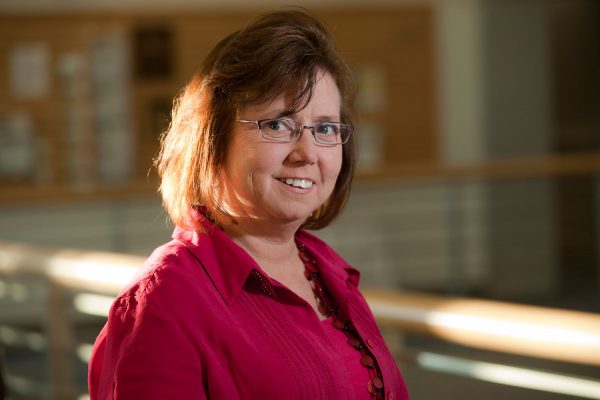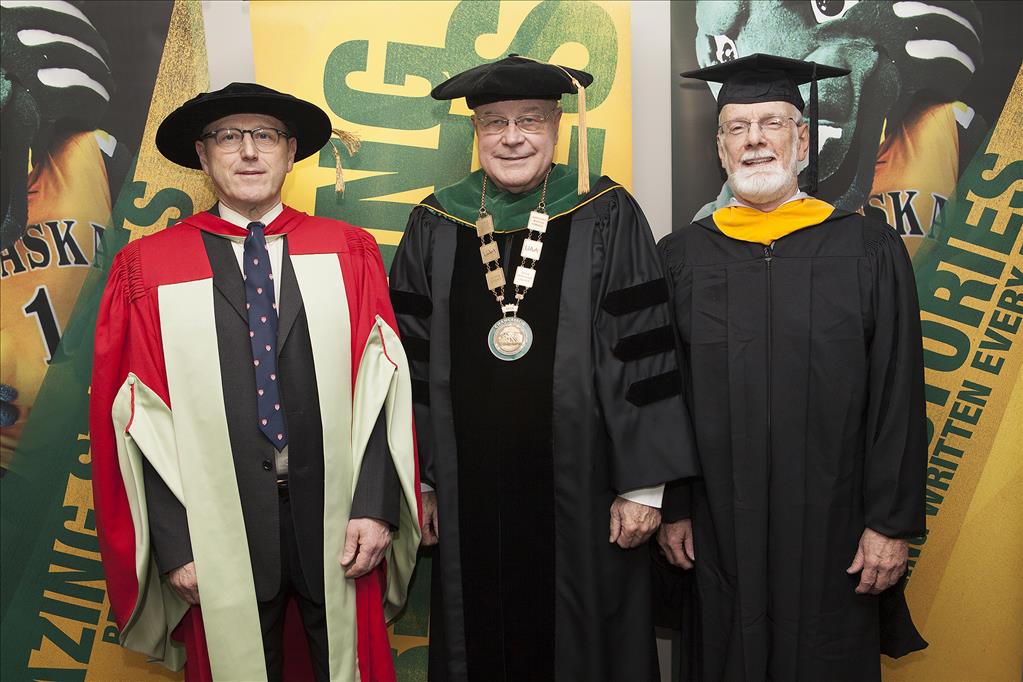How will Alaska Native corporations change?
by Kathleen McCoy |

Sharon Lind is one of the founding faculty for an Alaska Native corporation management
curriculum at UAA. She organized a panel on the Alaska Native corporation business
model for a recent conference at UAA. (Photo by Ted Kincaid / University of Alaska
Anchorage)
UAA recently hosted an Alaska Native Studies Conference that drew 400 participants to 48 panels and two keynote addresses.
The conference theme was wellness and healing. I headed into Rasmuson Hall for a session on Alaska Native Business Models. UAA's College of Business and Public Policy has a minor on Alaska Native corporation business management. Professor Sharon Lind is one of the founding faculty members for that program, and she'd organized this panel, explaining that wellness includes healthy corporations.
Ins and outs of '7(i)'
Her panelists offered a fascinating glimpse into elements that make these corporations unique. The panel had three sections: a look at 7(i) rules that require sharing of profits, a forecast on the longevity of Native corporations, and a discussion on inequality among Alaska Native peoples under the corporate model.
First, 7(i)rules. They apply to the 12 regional corporation with a land base. If a regional corporation develops natural resources on ANCSA-selected lands, 7(i) requires that it share profits with other regional corporations. The split is 30 percent retained by the developing corporation, and 70 percent shared. The sharing is based on the original shareholder population in the region at the time the ANCSA settlement occurred.
Only profits are shared this way. If a corporation loses money on a venture, that loss isn't shared in the same way.
Two of Lind's students, Sloane Unwin and Kathy Wilhelm, spent a semester interviewing Native corporate leaders to get their perspective on 7(i). Because the rule is controversial, they protected the identity of their commenters. Opinions varied from support for the indigenous value of sharing, to disgruntlement and concern that the rule keeps corporations from taking the risk to develop resources.
Said one respondent: "It depends on if you are the giver (then the sharing is always too high), or a receiver (then the sharing is always too low)." Another referred to the 70-30 split as an excessive "tax" that should be closer to a 50-50 split.
Wilhelm closed the session noting that views on 7(i) and its fairness vary. "But what is not an opinion is that natural resources are limited and declining and the global market for these resources is volatile right now...Because of this pressure, we anticipate new discussion on the future 7(i) revenue provisions. Or maybe the discussion is what regional and village corporations will do when there is no 7(i) revenues. Perhaps that discussion starts now."
Corporate longevity
The next focus looked at longevity for the Native corporations. Lind and her brother, Robert Snigaroff, an economics doctoral student at UAF, collaborated on research. They made the sobering point that all corporations terminate at some point.
They noted that the aggregate shareholder equity in 1982 was $400 million and today it is $3.9 billion, or a 9-fold increase. Still, they showed how corporate profits had been flat for about a decade.
Snigaroff made two points: corporations-all corporations-are risky. Across the corporate world, closure rates and forced mergers are on the rise.
"There is a way to calculate the expected life of a company," he said, by dividing 1 by the closure rate. A closure rate of 10 percent (or .10) gives you a 10-year lifespan. A 5 percent closure rate give you a 20-year lifespan.
"One thing to point out," Snigaroff added, "is....all of these companies will fail. It is just a question of how long it takes. I know that sounds alarming, but it is a reality we need to be cognizant of."
Added Lind: "There is not just an assumption by shareholders of Native corporations that these companies will live forever. There is actually an expectation by our people that these companies will be here in perpetuity for generations to come...what does it look like in 20 years? 50 years? 100 years?
"Looking at the forecasts, the expectations of our shareholders and our birth rates, we have to keep this [probability of failure] in mind," she said.
Equality under the corporate structure
Edgar Blatchford, a professor of journalism and public communication at UAA, spoke last. The argued inequality among Alaska Native peoples rose once they became shareholders.
"When Congress passed ANCSA in 1971, all soon-to-be shareholders expected and assumed they would be treated as equals," Blatchford said. "Despite the fact that ANCSA was called experimental, that idea quickly died as regional corporations adopted the rules of governance of publicly traded corporations, which were and are used to quell dissent and constructive comments."
He likened combining Native values with a corporate model to "putting cats on a dog team. It doesn't work." He said the result "has been an alienation of two-thirds of the Alaska Native community."
Optimistically, Blatchford projected great future wealth for Alaska. "We are moving into an era where the resources of the Arctic are going to be extractable-leading to enormous wealth." Later, in the Q and A, he predicted that the privately held Native corporations would go public.
At least one member of the audience took issue with Blatchford's repeated reference to ANCSA as an "experiment."
"I don't like the idea of calling this an experiment," said Willie Hensley, who helped broker the land settlement. "People can call it an experiment if they want to, but the reality is we were on the verge of losing it all in 1966. ... In our mind, if we were trying to allow for the continuation of our cultures, you have to have the land."
Hensley was philosophical about change. "If the identity is lost over time, will we have failed? Not necessarily. People change. In 30 years, if we lose our identity, we are going to lose the corporations. Because there is always value in the land, right? If there is no connection to culture and spirit, they will vote for the dollars.
"But does that make it wrong? Not necessarily," Hensley said. A version of this story by Kathleen McCoy appeared in the Alaska Dispatch News on Sunday, April 24, 2016.
 "How will Alaska Native corporations change?" is licensed under a Creative Commons Attribution-NonCommercial 4.0 International License.
"How will Alaska Native corporations change?" is licensed under a Creative Commons Attribution-NonCommercial 4.0 International License.














